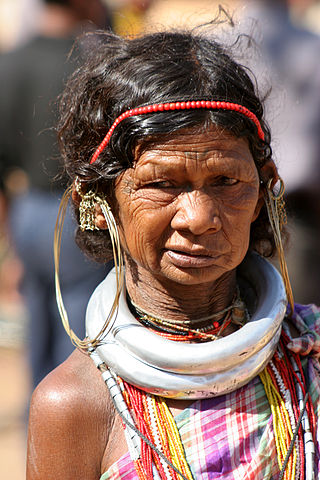Related Research Articles

Brahui is a Dravidian language spoken by the Brahui people who are mainly found in the central Balochistan Province of Pakistan, with smaller communities of speakers scattered in parts of Iranian Baluchestan, Afghanistan, and Turkmenistan and by expatriate Brahui communities in Iraq, Qatar, and the United Arab Emirates. It is isolated from the nearest Dravidian-speaking neighbouring population of South India by a distance of more than 1,500 kilometres (930 mi). The Kalat, Khuzdar, Mastung, Quetta, Bolan, Nasirabad, Nushki, and Kharan districts of Balochistan Province are predominantly Brahui-speaking.

The Dravidian languages are a family of languages spoken by 250 million people, mainly in South India, north-east Sri Lanka, and south-west Pakistan, with pockets elsewhere in South Asia.

Tamil is a Dravidian language natively spoken by the Tamil people of South Asia. It is one of the two longest-surviving classical languages in India, along with Sanskrit, attested since c. 300 BCE.

Malayalam is a Dravidian language spoken in the Indian state of Kerala and the union territories of Lakshadweep and Puducherry by the Malayali people. It is one of 22 scheduled languages of India. Malayalam was designated a "Classical Language of India" in 2013, citing its 2,500 years of continuous usage. Malayalam has official language status in Kerala, Lakshadweep and Puducherry (Mahé), and is also the primary spoken language of Lakshadweep. Malayalam is spoken by 35 million people in India. Malayalam is also spoken by linguistic minorities in the neighbouring states; with a significant number of speakers in the Kodagu and Dakshina Kannada districts of Karnataka, and Kanyakumari, Coimbatore and Nilgiris district of Tamil Nadu. It is also spoken by the Malayali Diaspora worldwide, especially in the Persian Gulf countries, due to the large populations of Malayali expatriates there. They are a significant population in each city in India including Mumbai, Bengaluru, Chennai, Delhi, Hyderabad etc.

Telugu is a Dravidian language native to the Indian states of Andhra Pradesh and Telangana, where it is also the official language. Spoken by about 96 million people (2022), Telugu is the most widely spoken member of the Dravidian language family, and one of the twenty-two scheduled languages of the Republic of India. It is one of the few languages that has primary official status in more than one Indian state, alongside Hindi and Bengali. Telugu is one of the six languages designated as a classical language by the Government of India. It is the 14th most spoken native language in the world. Modern Standard Telugu is based on the dialect of erstwhile Krishna, Guntur, East Godavari and West Godavari districts of Coastal Andhra.

Tulu is a Dravidian language whose speakers are concentrated in Dakshina Kannada and in the southern part of Udupi of Karnataka in south-western India and also in the northern parts of the Kasaragod district of Kerala. The native speakers of Tulu are referred to as Tuluva or Tulu people and the geographical area is unofficially called Tulu Nadu.

Fatehabad district is one of the twenty two districts of the state of Haryana, India. Fatehabad was founded by Firuz Shah Tughlaq. Fatehabad district was carved out of Hisar district on 15 July 1997.

Kolami is a tribal Central Dravidian language spoken in Maharashtra and Telangana states of India. It falls under the Kolami–Naiki group of languages. It is the most widely spoken Central Dravidian language.

Korku is an Austroasiatic language spoken by the Korku people of central India, in the states of Madhya Pradesh and Maharashtra. It is isolated in the midst of the Gondi people, who are Dravidian, while its closest relatives are in eastern India. It is the westernmost Austroasiatic language.

The Dravidian peoples, Dravidian-speakers or Dravidians, are a collection of ethnolinguistic groups native to South Asia who speak Dravidian languages. There are around 250 million native speakers of Dravidian languages. Dravidian speakers form the majority of the population of South India and are natively found in India, Pakistan, Afghanistan, Bangladesh, the Maldives, Nepal, Bhutan and Sri Lanka. Dravidian peoples are also present in Singapore, Mauritius, Malaysia, France, South Africa, Myanmar, East Africa, the Caribbean, and the United Arab Emirates through recent migration.
Fateh Jang Tehsil is an administrative subdivision (tehsil), of Attock District in the Punjab province of Pakistan lying between 33°10′ and 33°45′ North, and 72°23′ and 73°1′ East. The tehsil is administratively subdivided into 14 Union Councils.
The Ollari language is a Central Dravidian language. A closely related variety is Kondekor. The two have been treated either as dialects, or as separate languages. They are spoken in and around Pottangi, Koraput district, Orissa and in Srikakulam District, Andhra Pradesh, India.

The Gadaba or Gutob people are an ethnic group of eastern India. They are a designated Scheduled Tribe in Andhra Pradesh and Odisha
Duruwa or Dhuruwa or Parji is a Central Dravidian language spoken by the Duruwa people of India, in the districts of Koraput in Odisha and Bastar in Chhattisgarh. The language is related to Ollari and Kolami, which is also spoken by other neighbouring tribes.
Pandy Malayalam or Pandyan Malayalam is a dialect of Malayalam spoken by immigrants from Pandian kingdom in those regions of Kerala. It is the most spoken dialect in the district of Trivandrum and, according to an 1875 work by Robert Caldwell, this was also the case then in southern parts of Kollam district.
The Kondekor language is a Central Dravidian language. A closely related variety is Ollari. The two have been treated either as dialects, or as separate languages. They are spoken in and around Pottangi, Koraput district, Orissa and in Srikakulam District, Andhra Pradesh, India.
Konda-Dora, also known simply as Konda or Kubi, is a Dravidian language spoken in India. It is spoken by the scheduled tribe of the Konda-Dora, who mostly live in the districts of Vizianagaram, Srikakulam, and East Godavari in Andhra Pradesh, and the Koraput district in Odisha.
Kuvi is a South-Central Dravidian language spoken in the Indian state of Odisha. The language is one of two spoken by the Kandhas, with the other being the closely related and more dominant Kui language. According to the 2011 Indian census, there are around 155,000 speakers. The orthography is the Odia script. The grammatical structure of this language is comparable to other similar languages such as Kui which all fall under the classification of a Dravidian language.
Mullu Kurumba is a Southern Dravidian language closely related to Malayalam.
Jenu Kurumba, also known as Jen Kurumba or Jennu Kurumba, is a Southern Dravidian language of the Tamil–Kannada subgroup spoken by the Jennu Kurumba/Kattunayakan tribe. It is often considered to constitute a dialect of Kannada; however, Ethnologue classifies it as a separate language. Jenu Kurumba speakers are situated on the Nilgiri Hills cross-border area between Tamil Nadu and Karnataka, Mysore and Kodagu districts of Karnataka, and Wayanad district of Kerala. The speakers of the language call it "nama basha".
References
- ↑ Allar at Ethnologue (18th ed., 2015) (subscription required)
- ↑ V. Zvelebil (1997) "Language list for Dravidian," Archiv Orientální 65:175-190